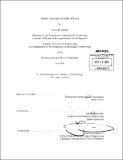Binary actuation of solar mirrors
Author(s)
Gomez, Teresa M
DownloadFull printable version (2.673Mb)
Other Contributors
Massachusetts Institute of Technology. Dept. of Mechanical Engineering.
Advisor
Steven Dubowsky.
Terms of use
Metadata
Show full item recordAbstract
This thesis explores the use of binary actuators to adjust the shape of an array of mirrors. To explore this concept, an experimental system was refurbished and recalibrated. This experimental system was used to explore the range of possible configurations that could be reached by a simple binary actuated system. System models are required for accurate control of these binary actuated structures. This thesis develops and tests the accuracy of two different modeling approaches, linear and iterative. The linear model assumes that each actuator contributes a constant value to the angle of the center mirror, and that this value is not dependent on the other actuator positions. The actuator contributions are summed to find the angle of the center mirror. These contributions are found two ways: by taking a relevant single data point for each actuator, and by using a least squares fitting of a large subset of data. The iterative model assumes that each actuator adds some constant value, similar to the previous model, and that it also adds some portion of the current angle. A multiplication and shift are therefore found for each actuator, and these multiplications and shifts successively applied, starting with the initial angles, to find the final angular position. While the linear model with measured values for the actuator contributions predicted the data poorly, the linear model with the least squares fitted values performed much better. The iterative model initially produced large errors, but these errors were found to be readily correctable and once removed, the iterative model predicted the data better than the linear model.
Description
Thesis (S.B.)--Massachusetts Institute of Technology, Dept. of Mechanical Engineering, 2011. Cataloged from PDF version of thesis. Includes bibliographical references (p. 42).
Date issued
2011Department
Massachusetts Institute of Technology. Department of Mechanical EngineeringPublisher
Massachusetts Institute of Technology
Keywords
Mechanical Engineering.